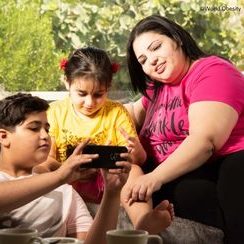Steps for success
Be a good role model
Children learn by example, you can encourage your child to be active and eat well by doing so yourself. Set a good example by going for a walk or bike ride instead of watching TV or sitting at your computer. Playing in the park or swimming with your children shows them that being active is fun, and it’s a great way for you to spend time together.
Any changes you make to your child’s diet and lifestyle are much more likely to be accepted if the changes are small and involve the whole family.
Get active
All children should aim to do at least 60 minutes of physical activity a day for good health, but it doesn’t need to all be done at once. Several short 10-minute, or even 5-minute bursts of activity throughout the day can be just as good as an hour-long stretch.
Younger children can take part in active play including ball games, chase games like ‘tig’, riding a scooter, using playground swings, climbing frames and see-saws. Older children can ride bikes, skateboard, walk to school, skip, swim, dance or get involved with martial arts.
Walking or cycling short distances instead of using the car or bus is a great way to be active together as a family. And you’ll save money, too.
Child-sized portions
Avoid feeding your child oversized portions. Start meals with small servings and let your child ask for more if they’re still hungry.
Don’t insist your child finishes everything on their plate or eats more than they want to. Avoid using adult-size plates for younger children as this can encourage them to eat oversized portions. It may also help if you ask your child to eat slowly and keep set mealtimes. Mealtimes are a great opportunity to catch up on what’s happened during the day.
Eat healthy meals
Be aware that unsweetened 100% fruit juice, vegetable juice and smoothies can only ever count as a maximum of 1 portion of their 5-A-Day. For example, if they drink two glasses of fruit juice and a smoothie in one day, that still only counts as one portion. When fruit is blended or juiced, it releases sugars, which increase the risk of tooth decay. So it’s best to drink fruit juice or smoothies at mealtimes.
It’s healthier for your child to get most of their calories from healthy foods like fruit and vegetables, and starchy foods like bread, potatoes, pasta and rice. Try to limit the amount of sugary or high-fat foods like sweets, cakes, biscuits, sugary cereals, and sugar-sweetened soft and fizzy drinks. These foods and drinks tend to be high in calories and low in nutrients.
Less screen time and more sleep
It’s a good idea to get your child moving and reduce the time they spend sitting or lying down during the day. Limit the amount of time they spend being inactive, watching TV, playing video games and playing on electronic devices.
Generally experts advise that children should watch no more than two hours of television each day and you should remove all screens (including mobile phones) from their bedroom at night. Sleeping well helps children to grow and maintain a healthy weight and can have a positive effect on their mood and behaviour.
If your child has a medical condition, you should check with your GP or health professional if you have concerns about their weight.
‘Fussy Eating’
Many children go through a period of refusing some foods as a natural part of their development. Although it can be worrying for parents, it will often resolve with time.
Follow our top tips to help fussy eating:
- Stay calm during meal times to avoid anxiety, ignore any food refusal but offer the same food again at another meal time.
- Never force feed your child, as this can put them off food even more. Accept that it’s natural for children to reject new or bitter foods, and trust that they will eat if they are hungry.
- Do not give food as a reward as this may encourage bad habits later in life. Instead offer objects and experiences such as a small toy, a comic, or a trip to the park
- Try to sit down and eat as a family as often as possible, we all lead busy lives and it is not always easy but aim to do this at least a couple of times a week.
- Be a good role model, if your child sees you eating a variety of foods then they are more likely to try new foods.
- Serve appropriate sized portions so your child is not overwhelmed.
- Invite other children for meals as children will often copy the behaviour of their friends.
- Focus on preparing meals your child will eat and build on those.Look at how you can introduce new foods into these meals. For example, grating vegetables into spaghetti Bolognese.
- Try to avoid children filling up on drinks and snacks before their meal.
- Try using sticker charts for eating new foods and reward them for trying a certain amount of new foods.
- Occasionally, ‘fussy eating’ may develop into a more extreme form of food refusal. If parents are concerned, they should speak with their GP or paediatrician.









